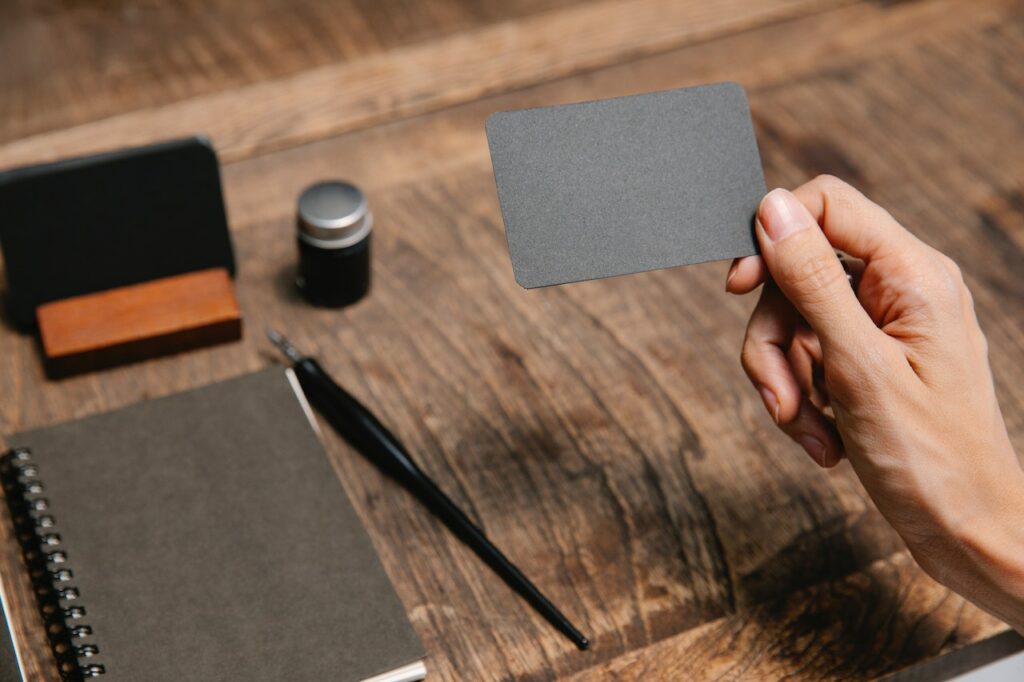Ultimate Guide to Business Card Sizes & Design Best Practices
A business card may be small in size, but it carries significant weight in the world of networking and professional relationships. It embodies your brand or your company’s identity, serving as a tangible representation of who you are and what you do. We will talk about the standard dimensions of business cards worldwide, the importance of size, factors influencing size selection, and how to strategically design a business card that effectively communicates your brand.
Business Card Sizes

Standard business card sizes can vary by country. Here are some of the most common sizes
- United States and Canada: 3.5 inches x 2 inches (88.9 mm x 50.8 mm).
- Europe: 3.37 inches x 2.12 inches (85 mm x 55 mm).
- Japan: 3.58 inches x 2.165 inches (91 mm x 55 mm).
- China: 3.54 inches x 2.125 inches (90 mm x 54 mm).
- Australia and New Zealand: 3.54 inches x 2.165 inches (90 mm x 55 mm).
- ISO 7810 ID-1 (credit card size): 3.37 inches x 2.125 inches (85.6 mm x 53.98 mm).
Remember that these dimensions refer to the finished card size. When designing, you should include a “bleed area”—an extra 1/8 inch around the sides of the card to avoid any cutting errors.
Standard Dimensions of Business Cards Worldwide
Regarding the size of business cards, there is a variety of standards. Different countries and regions have their conventions. However, there are certain commonly recognized dimensions.
The standard business card size in the United States and Canada is 3.5 inches by 2 inches (88.9mm x 50.8mm). This has been the North American standard for many years, offering a good balance between size and space for information.
In most European countries, the ISO 7810 ID-1 standard is followed, which is slightly larger than the North American standard at 85.60mm x 53.98mm. This is also the standard credit card size.
The typical business card size is 90mm x 55mm in Australia, New Zealand, and parts of Asia. This gives more room for information compared to the North American and European standards.
The Importance of Size
While the size of a business card may seem like a minor detail, it plays a crucial role in the effectiveness of the card as a networking tool. Here’s why:
Portability: The small size of a business card makes it conveniently portable. It’s designed to fit easily into wallets, card holders, and pockets, encouraging recipients to keep the card and refer back to it when needed.
Usability: A business card’s dimensions should provide enough space to include essential contact information without cluttering the card. Too much information can be overwhelming and detract from the card’s primary purpose – to serve as a quick reference.
Consistency: Using a standard size for your business cards can help reinforce your professionalism. It shows that you understand and respect business conventions, which can enhance your credibility.
Business Card Design Best Practices

Designing an effective business card requires you to balance a variety of factors. Here are some of the best practices for creating a business card
- Include all relevant information
Stick to the basics and include the following: Company name, your name and job title, logo, email address, phone number, website address, and social media accounts. Also, consider including a tagline or a QR code, which can provide additional information about your brand. - Choose a design that reflects your brand’s personality
Your business card should be a physical representation of your brand’s personality. Whether vibrant, creative, simple, or professional, ensure that your card’s design aligns with your brand. - Please remember your font type and size
Make sure your business card is easily read by choosing polished, straightforward, and simple fonts. The ideal font size should be between 10 and 16 pt for the names, headings, and primary text and smaller for supporting readers like contact information. Remember not to use more than three fonts, making the card look messy. - Decide on your logo design.
Your logo deserves a prominent place on your business card. You can place it in the upper left corner, use it as a background, or put it in the center with other elements surrounding it.
. - Choose colors carefully
People are likelier to keep a colorful business card but choose your colors wisely. They should reflect your brand and the services you offer. Also, consider your target audience when selecting colors. - Take into account brand identity with card size and shape
While standard sizes are expected, you can get creative with the shape of your card to make it stand out, as long as it aligns with your brand’s identity. - Consider white space
This refers to the blank space on your card where content can breathe. It can be achieved by eliminating irrelevant titles, switching from text to icons, or selecting simple template designs. - Think about the material
High-quality materials make your business card more appealing to the touch. Use good stock paper or unique designs with unconventional materials like plastic, metal, wood, cork, or fabric. The print should be resistant to water and other potential damages.
Virtual Business Cards
In today’s digital age, physical business cards are supplemented by virtual ones. A virtual business card is an online way to share contact information in real-time. They are more customizable, can contain more information than traditional business cards, such as videos and PDFs, and can have different colors.
The recipient doesn’t need any particular app to receive a virtual business card. It can be shared through QR codes, email, text, WhatsApp, and social media. Creating a virtual business card automatically includes a QR code, which you can customize to fit your brand’s logo with a premium plan.
Factors Influencing Size Selection
When deciding on the size of your business card, there are several factors you might want to consider
Brand image
Your brand image plays a significant role in determining the design of your business card, including its size. For instance, a creative agency might opt for a non-standard card size or shape to reflect its out-of-the-box thinking, while a law firm might stick to a standard size to convey its professionalism and stability.
Budget
The cost of producing business cards can vary depending on the size. Standard-sized cards are often less expensive to produce than non-standard sizes, which may require custom cutting and could lead to more waste during the printing process.
Information to be included
The amount of information you want to include on your card can influence its size. If you have a lot of information to convey – such as multiple contact methods, a logo, and perhaps a slogan or list of services – you may need a larger card. However, remember that clarity and ease of reading are key. Overloading a card with information can be counterproductive.
Summary
A well-designed business card can be a powerful networking tool. Whether you opt for a physical or virtual card, ensure it reflects your brand, contains all the necessary information, and is designed with the recipient in mind. Following these best practices will help you create a business card that leaves a lasting impression and helps you stand out.
